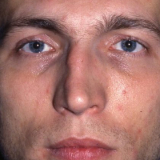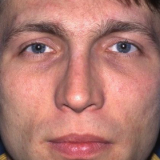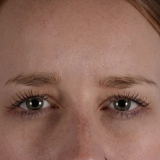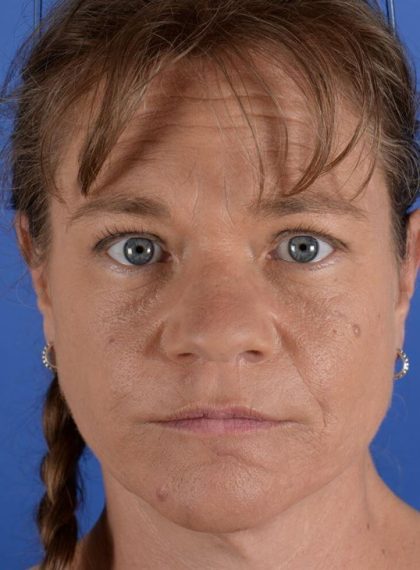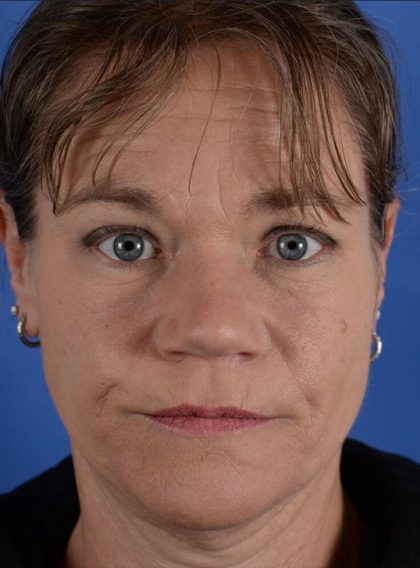Primary Rhinoplasty
Conveniently located to serve the areas of Englewood and Denver, CO

Primary rhinoplasty is a surgical nasal reshaping procedure performed on a patient who has never had rhinoplasty surgery in the past. Primary rhinoplasty is used to improve the cosmetics of the nose or compromised nasal function such as breathing obstruction or to improve both form and function simultaneously in the same patient. Rhinoplasty is considered the most challenging cosmetic plastic surgical procedure and has the highest rate of secondary or revision surgery.
At Colorado Facial Plastic Surgery, Dr. David M. Kowalczyk and Mario J. Imola offer the best primary rhinoplasty procedures that can enhance the overall appearance of your face. Renowned plastic surgeons like Dr. Imola and Dr. Kowalczyk are the obvious choice when it comes to receiving an effective rhinoplasty the first time around.
For more information, call our office at (303) 839-7980 or contact us online.
Before and After Photos
Contents
- 1 Before and After Photos
- 2 Preparing For Your Primary Rhinoplasty Consultation
- 3 Nasal Photography and Computer Simulation
- 4 Choosing the Best Primary Rhinoplasty Surgeon For You
- 5 Nasal Anatomy and Cosmetic Analysis
- 6 Benefits of Primary Rhinoplasty
- 7 The Primary Rhinoplasty Procedure
- 8 What To Expect Following Primary Rhinoplasty: The Postoperative Course
- 9 Postoperative Care Following Rhinoplasty
- 10 How Much Does Primary Rhinoplasty Cost in Denver?
- 11 FAQ
- 11.1 What are the complications following rhinoplasty?
- 11.2 When can I resume activities following rhinoplasty?
- 11.3 When can I return to work following rhinoplasty?
- 11.4 When can I fly following rhinoplasty?
- 11.5 When will the final result be visible?
- 11.6 What type of anesthesia is used for rhinoplasty?
- 11.7 What is the revision rate following primary rhinoplasty?
- 11.8 What is the most common reason for major revision following primary rhinoplasty?
- 12 References
Preparing For Your Primary Rhinoplasty Consultation
At the initial rhinoplasty consultation the most important objective is to accurately communicate to a prospective surgeon your goals to reshape your nose and any problems you are experiencing with nasal function. It is a good idea to become familiar with some basic nasal anatomy so as to better understand what determines the shape of the nose and the basic ways in which to change the shape. Take some time to perform a cosmetic analysis of your own nose and try to identify the main features you want to change. Refer to the nasal anatomy and cosmetic analysis section to learn more.
In addition to identifying the changes desired to nasal form, it is also important to think about any deficits in nasal function that may be present. Obstruction may be present all the time (fixed) or may fluctuate during the day or from week to week. Air passage may also be different from side to side. Certain activities or situations can aggravate nasal obstruction such as strenuous activity, deep forceful inspiration, and head position lying down or when sleeping.
To schedule your primary rhinoplasty consultation, call (303) 839-7980 or fill out this form.
Nasal Photography and Computer Simulation
Photography is key to successful rhinoplasty and it is essential that photographs be taken before and after using the same lighting, exposure angles, and equipment in order to make unbiased assessments of the changes made. The various organizations and societies of plastic surgery have established rigid guidelines and standards for photography that surgeons should adhere to. Prospective patients should be wary of any office that does not have a dedicated photo room with proper high-quality photographic equipment.
When reviewing before and after photos, pay close attention to the lighting and angles that the photos are taken with to ensure it is the same in both. The lighting and exposure can make a huge difference in the appearance, especially in the front and oblique views. Computer simulation should be available in every rhinoplasty surgeon’s office. It is critical to help the surgeon understand what the patient is looking for and help the patient determine the best changes for them.
Once the goals are established using computer-simulated images, the surgeon now has a target to assist in planning the surgical maneuvers that will be used to deliver the outcome. Please note, however, that the computer-generated images are guidelines and not a guarantee of results. The surgeons at Colorado Facial Plastic Surgery are proponents of standardized, consistent photography and computer simulation to achieve the best results possible.
Choosing the Best Primary Rhinoplasty Surgeon For You
Apart from clearly defining the goals for primary rhinoplasty surgery, the next most important task as a patient is to carefully select the surgeon that you feel is best able to deliver what you desire. Several factors should be considered.
- The overall experience and vibe during the consultation. The consultation ideally should be thorough, complete, and welcoming. Does the surgeon take the time to understand what you want? Does he or she really try to nail down your objectives with discussion and comments? Are you allowed to ask questions and are the answers fully explained? In short, is the appropriate amount of time taken to get to know you and what you want? Also important is your level of confidence in the surgeon and the office. Do you believe the surgeon can deliver what he or she is promising and does the office instill a sense of top-notch perioperative and postoperative care? The vibe is a personal feel or “gestalt” that you get from the surgeon and the office as a whole and should make you feel as if you are in the right place.
- Before and After Photos. The photo gallery is the single most important yardstick available to gauge how good the surgeon’s results are. Spend a good amount of time to carefully analyze the photos in the photo gallery and compare them to other surgeons you may be considering. Is the lighting and exposure consistent between the before and after photos? Are all the standardized views available for each patient (frontal, lateral, oblique, base)? Remember that the most important view is the frontal view because this is how we primarily interact with others. Unfortunately, it seems that too many photo galleries focus only on the lateral view to demonstrate hump reduction. Remember that if it doesn’t look good from the front then it is not a success.
- Reviews. Prior patient experience is a critical component in validating the results seen in Before and After photo galleries.
- How big a focus is rhinoplasty in the practice? Ideally, rhinoplasty should be the primary focus at the office. At Colorado Facial Plastic Surgery, rhinoplasty is our primary focus and we represent the foremost rhinoplasty center in the Rocky Mountain region with a national referral reach.
- Experience. Most experienced rhinoplasty surgeons will tell you that it takes 5 to 10 years to finally get to the point where they feel comfortable with rhinoplasty surgery. Generally, a minimum of 50 cases a year and ideally over 100 cases per year are required.
- Training & Board Certification. There are 2 broad groups of plastic surgeons performing rhinoplasty surgery. Surgeons who receive residency training in the discipline of Otolaryngology (ENT)-Head & Neck Surgery and those who complete a General Plastic Surgery residency. However, additional exposure beyond residency to rhinoplasty is critical to developing adequate expertise. Board Certified facial plastic surgeons undergo fellowship training beyond ENT-Head and Neck surgery residency where they are exposed to 1 or more years of plastic surgery devoted to only the face. Board-certified general plastic surgeons who wish to develop a robust rhinoplasty practice ideally complete a fellowship focused on the head and neck as well. It is challenging to be an expert in both body and facial plastic surgery.
Nasal Anatomy and Cosmetic Analysis
The basic anatomy of the nose can be described as a skin and soft tissue envelope draped over a cartilage and bone framework and lined by a moist mucosal lining. (1) Changing the shape of the nose mostly involves altering the shape of the bone and cartilage framework. The bony framework is contributed to by the nasal bones proper as well as extensions from the maxilla (upper jaw) and from the frontal bone (forehead).
There are 5 main cartilage elements contributing to the nasal framework: a pair of upper lateral cartilages comprising the middle third sidewalls, another pair of lower lateral cartilages comprising the dome and tip, and a midline cartilage plate known as the cartilaginous nasal septum which is a key supporting element extending back into the nasal cavity.
The nose can be divided into cosmetic subunits to assist in describing its cosmetic features. (1) The upper third is known as the radix and corresponds to the region between the eyes where the forehead meets the nose. The middle third consists of the nasal bridge and vault. The bridge specifically refers to the central region of the nasal vault and its shape is largely influenced by the nasal septum.
The remainder of the vault is formed by the right and left sidewalls supported by the nasal bone framework as well as the upper and lower lateral cartilages. The nasal tip and dome regions are primarily shaped by the intermediate and lateral crus of the lower lateral cartilages. The tip specifically refers to the very center of this region at the most projected areas known as the tip defining points. Other parts of the dome include the supratip and the infratip. The nasal base is composed of distinct elements known as the ala (nostril), the columella (midline extension from the tip to the upper lip), and the sill (ridge between the base of each nostril and the central upper lip).
A systematic cosmetic nasal analysis will help in accurately determining what changes may or may not be desirable. A good approach is to begin with the overall size and shape. For example, is the nose too long, is it too wide, and if so where, does it stick out too much (over-projected) or not enough (under-projected)? The shape can be assessed by looking at each aesthetic sub-unit. In the upper third of the nose (radix) a key point is to determine if the angle between the forehead and the nose is too deep or too flat. The middle segment of the nose is composed of the bridge and the sidewalls or nasal vault. This area can show asymmetry in the crooked nose with either a straight-line deviation, a C-shaped or reverse C-shaped curvature, or an S-shaped deformity.
The side walls of the nose can also be asymmetric leading to a tilted appearance of the nasal vault. The bridge can be over-projected when a nasal hump is present or can be too wide or too narrow. The shape of the tip and dome area of the nose is key in imparting a refined appearance. If this area has a wide, bulbous, or boxy appearance, then the nose will not have a refined look. The tip can also be over-projected (sticks out too far), overly down-rotated (hangs too low), or overly up-rotated (a pug-nose appearance).
The last area to consider is the base of the nose consisting of the ala (the outer part of the nostril opening), columella (the inner part of the nostril opening and sill region (the bottom of the nostril opening). Unfavorable appearances can be a nasal base that is too wide, nostrils that are too flared, retracted nostril margins (contributing to excessive nostril show), a hanging columella (also contributing to excessive nostril show), or asymmetry due to different nostril shapes between the right and left. This top-down simplified method to analyze your nose is by no means complete but serves as a good starting point. Additional features can be explored during an in-depth consultation.
Benefits of Primary Rhinoplasty
The benefits of receiving a primary rhinoplasty procedure at Colorado Facial Plastic Surgery include:
- Improved nasal function and breathing
- Better sleep due to unobstructed nasal breathing
- Alleviated sinus problems
- Correcting the nose after a traumatic injury
- Improved self-confidence and self-esteem
Furthermore, the cosmetic benefits include:
- Making the nose smaller
- Making the nose straighter
- Reducing bumps and bulbousness on the nose
- Optimizing the size of the nostrils
- Normalizing the appearance of the nose in general
Denver’s Top Rhinoplasty Surgeons
Selecting a plastic surgeon highly experienced in rhinoplasty ensures precision, expertise, and optimal outcomes, enhancing confidence and satisfaction with the results. Dr. Imola and Dr. Kowalczyk excel as rhinoplasty surgeons due to their unmatched skill, personalized approach, patient satisfaction, and track record of successful procedures.
The Primary Rhinoplasty Procedure
Open Versus Closed Approach (2-4)
In order to access the bone and cartilage framework either an open (external approach) or a closed (internal approach) type of approach can be used. Closed rhinoplasty is performed using incisions completely within the nostrils while open rhinoplasty adds a small incision across the columella. The advantages of an open approach include improved visibility and the ability to perform more maneuvers to modify the bone-cartilage framework with greater ease and precision. The disadvantages include prolonged swelling and in some cases visibility of the columellar scar at the base of the nose. At Colorado Facial Plastic Surgery, we use both open and closed techniques, tending to favor the open approach when a more complex primary rhinoplasty is required to achieve the desired goals.
Septoplasty (2,4)
The septum is the pillar of the nose and the main determinant of a straight nose. Therefore, significant asymmetry needs to be definitively corrected. Several methods are available depending on the degree of the deformity such as removal of deviated segments, release of intrinsic cartilage tension causing deviation, and cartilage grafts placed as either onlay reinforcements or as extension grafts. Occasionally complete septal reconstruction or replacement is necessary.
Reducing the Bridge (Hump Removal) (3-4)
One of the most common requests from people seeking primary rhinoplasty is to remove an undesirable hump deformity or over-projected bridge. This can be performed with a combination of chisels, rasps, and knives or with powered instrumentation such as drills or ultrasonic tools. Following the mechanical removal of a dorsal hump, it is critical to restore the integrity of the upper lateral cartilages and dorsal free edge of the septum into a smooth construct using spreader grafts in order to prevent contour irregularities or, worse yet, an inverted-V deformity. (2,5)
Nasal Tip Repositioning
Another common request during primary rhinoplasty is to change the position of the nasal tip when it is down-rotated or drooping. In order to up-rotate the tip, the lower lateral cartilages are moved to up-turn the tip-defining points into a more favorable location. For severely drooping tips supporting grafts are typically used such as caudal septal extension grafts, lateral crural strut grafts, and tip onlay grafts.
Nasal Tip Reshaping
In addition to repositioning the nasal tip, reshaping the dome and tip can be performed to create a more sculpted, defined appearance with less overall size and width. This is typically performed with a combination of cartilage reshaping sutures and cartilage grafts. (2-8)
Nasal Base Modification
Modifications of the nostrils and adjacent nasal base region are frequently requested during primary rhinoplasty. Common procedures include nostril resections to decrease nostril flare, alar sill narrowing to draw the nostrils inwards and decrease the width of the nasal base, lower lateral cartilage repositioning, or alar rim grafts to improve excessive nostril retraction or reduction of a hanging columella.
Correcting Asymmetry
Improving nasal asymmetry is one of the most challenging components of rhinoplasty. Although a perfectly straight result is the ideal outcome, this is more commonly the exception rather than the rule. In most cases, the asymmetry is improved to a degree that the patient is happy they underwent the rhinoplasty surgery. Correcting asymmetry typically requires several surgical maneuvers including septoplasty, osteotomies to reset crooked nasal bones, and multiple cartilage grafts both in a support and camouflage role. (2,4-7)
Improving Function
The primary causes for nasal obstruction can be found at multiple sites within the nasal anatomic framework. During functional rhinoplasty, correcting obstruction generally begins with a properly executed septoplasty and straightening sidewall asymmetry as previously described. Other maneuvers are determined by the contributions from narrowed internal or external valves, stenosis of the nasal vestibule, or enlarged turbinates. Spreader grafts placed between the upper lateral cartilages and the septum can assist in opening the internal nasal valve while underlay lateral crural strut grafts are useful to improve support in the region of the external valves. Stenosis in the nostril or nasal vestibule is corrected using composite grafts of skin and cartilage obtained from the ear. A variety of turbinate reduction procedures to decrease obstruction due to the inferior turbinates are available including out-fracture, cautery reduction, ultrasonic reduction, or powered micro-debrider reduction.
Open Structure Rhinoplasty
Open structure rhinoplasty refers to a method of nasal reshaping surgery that emphasizes the use of supporting grafts critically placed throughout the bone and cartilage framework to create a stable shape for years to come while not imparting graft visibility or a bulky look. (2,7) The structural grafts required during primary surgery are typically obtained from non-critical areas of the cartilaginous septum. Not infrequently, the ear will need to be used as a donor site, and in rare occasions, rib cartilage will be necessary.
The majority of patients who present for major revision rhinoplasty will report that things looked “pretty good” for a year or so and then started to gradually collapse, shift, and deteriorate. When performing revision rhinoplasty in these cases, it is often noted that structural cartilage grafts are missing and the initial primary rhinoplasty was performed essentially using resection techniques with little or no attention paid to preserving structural support.
Dorsal Preservation Rhinoplasty
A recent development in primary rhinoplasty has emerged in the past 5 to 10 years known as dorsal preservation which aims to lower an over-projected hump on the nasal bridge while preserving otherwise favorable features of the dorsal anatomy. (9) While several methods have been described, the basic principle is to lower the bridge using the removal of bone cartilage further down along the nasal sidewalls and septum and unfolding and flattening the bone cartilage elements over the bridge which otherwise stays intact. This method of eliminating a hump on the bridge avoids the need to physically cut the bone and cartilage away and then tediously reattach all of the elements back into a smooth stable surface.
In order to achieve predictable outcomes careful selection prior to surgery is essential. The surgeons at Colorado Facial Plastic Surgery have both received training in dorsal preservation rhinoplasty and utilize this technique when indicated.
What To Expect Following Primary Rhinoplasty: The Postoperative Course
Pain following rhinoplasty is very manageable in general. Most patients will report mild to moderate pain for 2 to 3 days that may or may not require narcotics to control and after that can be managed with anti-inflammatory medications such as Tylenol. Bruising is more variable and depends on the various maneuvers used during surgery. If osteotomies are used then one can expect more bruising but this usually can be covered by makeup by 1 week following surgery. Swelling is also related to the number and types of maneuvers performed.
The peak swelling usually occurs at the 3 to 4-day point following surgery and then begins to quickly decline. By 1 month swelling has resolved to about 50% of the peak level and by 3 months to about 25% of the peak swelling that occurred during the 1st week. The remaining swelling then resolves very slowly so most surgeons claim that it usually takes 9 to 12 months for all of the swelling to resolve.
Numbness occurs due to disruption of all the nerve endings responsible for sensation as the skin envelope is dissected off the bone-cartilage framework. Sensation slowly improves for months following surgery and can take up to 1.5 years to fully recover. Due to swelling of the internal nasal lining, the majority of patients will experience some nasal congestion and difficulty breathing during the first few weeks which gradually improves over a few weeks.
Postoperative Care Following Rhinoplasty
Proper postoperative care following rhinoplasty is critical in ensuring the best possible outcome. (10) This includes meticulous wound care, an initial period of rest followed by a gradual increase in activity level, proper nutrition and diet modifications, perioperative medications, and if necessary manipulation and taping regimens. It is imperative that the patient keep the scheduled post-operative appointments so that the surgeon can monitor the healing progress and make the appropriate interventions that may be needed. Colorado Facial Plastic Surgery provides highly detailed instructions for patients embarking on rhinoplasty and reviews them in detail prior to surgery.
How Much Does Primary Rhinoplasty Cost in Denver?
The cost of primary rhinoplasty will vary based on the complexity of the surgery. The surgeon’s fee can range from $4,000 to $10,000 depending on the number of maneuvers that it will take to achieve the desired goals. Facility and anesthesia fees will generally add $3,000 to $5,000. To learn more about primary rhinoplasty and to book a personal consultation with Dr. Imola or Dr. Kowalczyk, call (303) 839-7980 or visit our contact page.
FAQ
What are the complications following rhinoplasty?
It is best to consider the complications following rhinoplasty as short-term and long-term. The more common short-term problems include bleeding and infection, however, even these are fairly rare. The long-term complications include functional problems with nasal obstruction being the most common.
When can I resume activities following rhinoplasty?
During the first week, it is best to limit exertion to non-strenuous daily activity. We encourage getting up and moving frequently during the day. Physical exertion can gradually build up in the second and third weeks so that by the end of the third week full strenuous activities can be resumed.
When can I return to work following rhinoplasty?
Most patients resume work 7 to 10 days following surgery. There will still be swelling present and bruising may need to be covered up using makeup at this point.
When can I fly following rhinoplasty?
Out-of-town guests can generally fly once the stents and sutures are removed at 6 to 7 days following surgery.
When will the final result be visible?
It generally takes up to 1 year for all of the swelling to fully resolve and the healing tissues to mature. However, by 3 to 6 months the general outcome should be apparent and any minor adjustments that need to be made should be discernible.
What type of anesthesia is used for rhinoplasty?
Primary rhinoplasty with significant changes, septoplasty, and structural cartilage grafting will generally require general anesthesia. Less complicated surgery with 2 or 3 maneuvers and no need for significant cartilage grafting can be performed using intravenous sedation (twilight anesthesia).
What is the revision rate following primary rhinoplasty?
It is important to distinguish minor revisions from major revisions. Minor revisions such as a small degree of nostril margin asymmetry are not uncommon and can easily be managed with a minor in-office revision under local anesthetic. Major revisions require more extensive surgery usually with IV sedation or general anesthetic similar to the original surgery. These situations are less common, however, they remain a distinct possibility.
What is the most common reason for major revision following primary rhinoplasty?
Major revision usually results from a lack of attention to detail during primary rhinoplasty especially as this pertains to ensuring adequate structural support. This can occur using either a closed or open approach and is most commonly seen when a reduction rhinoplasty is undertaken, cartilage is only removed and time is not taken to restore adequate structural support using cartilage grafts, especially when the primary rhinoplasty is being performed in a patient with poor intrinsic tip support to begin with. Colorado Facial Plastic Surgery is established as a center of excellence and the premier destination in the Rocky Mountain region for revision rhinoplasty. From their extensive experience, they believe that lack of attention to detail and preservation of support during primary rhinoplasty is the most common cause leading to the need for major revision.
References
- Tardy ME. Surgical Anatomy of the Nose. Raven Press, New York, 1990.
- Toriumi DM. Structure Rhinoplasty: Lessons learned over 30 years. DMT Solutions, Chicago, 2019.
- Sheen J. Aesthetic Rhinoplasty. QMP Quality Medical Publishing, St. Louis, 1998.
- Tardy ME. Rhinoplasty: The Art and Science. Saunders, Philadelphia, 1997.
- Daniel RK. Mastering Rhinoplasty. Springer-Verlag, Berlin, 2010.
- Toriumi DM. Nasal Tip Contouring: Anatomic Basis for Management. Facial Plastic Surgery & Aesthetic Medicine 2020 Feb;22(1):10-24
- Toriumi DM. Nasal Tip Contouring: Anatomic Basis for Management. Facial Plastic Surgery & Aesthetic Medicine. 2020;22(1):10-24. doi:https://doi.org/10.1089/fpsam.2019.29006.tor
- Gunter JP, Friedman RS. Lateral Crural Strut Graft: Technique and Clinical Applications in Rhinoplasty. 1997;99(4):943-952. doi:https://doi.org/10.1097/00006534-199704000-00001
- Toriumi DM, Kovacevic M. Dorsal Preservation Rhinoplasty. Facial Plastic Surgery Clinics of North America. 2021;29(1):141-153. doi:https://doi.org/10.1016/j.fsc.2020.09.009
- Toriumi DM, Kowalczyk DM, Cristel RT, et al. Evaluation of Postoperative Infection Rates in 3084 Rhinoplasty Cases Using Antibiotic Soaks and/or Irrigations. Facial Plastic Surgery & Aesthetic Medicine. 2021;23(5):368-374. doi:https://doi.org/10.1089/fpsam.2020.0465
